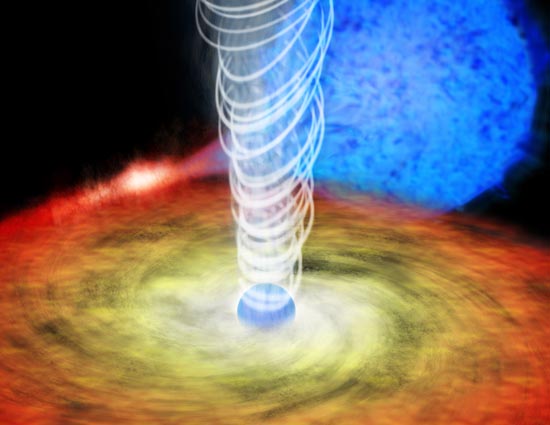A merger of a white dwarf with a neutron star or with a tiny black hole creates a tiny black hole, in a process that causes intense radiation, which we feel on Earth as cosmic radiation, or at least could be one of the sources of this strong radiation, state experts in the SLOAN sky survey

This type of cosmic rays originate from bodies outside the solar system and are much more energetic than those emitted by the sun, even though it is much closer. The merger between a white dwarf and a neutron star or black hole may be one of the sources of cosmic rays, and these sources may occur often enough to be the most significant source of these particle rays.
The SLOAN Observatory's White Dwarf Radial Velocity Survey (or SWARMS for short) which is part of the Sloan Digital Sky Mapping recently discovered a binary system containing two exotic objects 170 light years away from the Solar System. The object known as SDSS 1257+5428 is a white dwarf orbiting a low-mass neutron star or black hole. The study by Charles Badens and colleagues (http://arxiv.org/abs/0910.2709) is published in ARXIv.
One of the co-authors of the article, Todd Thompson, a professor in the Department of Astronomy at Ohio University, claimed in a letter published in the Astrophysical Journal Letters that this type of system, resulting in a merger of the two remnant stars, may be common, and there is a high probability that it is responsible for the high-energy cosmic rays observed from the sphere Country. The merger between a white dwarf and a neutron star or black hole may create a low mass black hole or "mini black hole".
In an email interview to the UNIVERSE TODAY website, Thompson writes: "Pairs of white dwarfs and neutron stars or black holes are considered rare, although there is a large variety of them in the Milky Way and in galaxies similar to it. Our survey was the first to discover such systems using the "radial velocity" method, and the first to discover such an object in the vicinity of the solar system, only about 170 light years from us. For this reason, it was a surprise. The relative proximity of the system allowed us to claim that these systems must be quite common compared to what we have thought so far. The SWARMS survey was not so lucky to see something so rare so close to the solar system.”
In the article, Thompson and his colleagues claim that this type of merger must be a significant source of the high-energy cosmic rays for the Milky Way, and that such a pair is expected to merge in our galaxy once every two thousand years or so. Such types of mergers are slightly less common than a Type Ia supernova, which originates from a binary system containing two white dwarfs.
For the news in Universe Today
Translation: Avi Blizovsky

3 תגובות
Ami, a tiny black hole is a black hole with about one solar mass or several solar masses compared to a black hole of millions of solar masses that lie in the centers of galaxies, therefore the mass of a black hole, if not the size, determines
The merger between a white dwarf and a neutron star or black hole may create a low-mass black hole or "mini-black hole"
I don't understand this sentence. A black hole will remain a black hole no matter what mass is added to it (as long as it is positive). I can understand that a collision of a white dwarf with a neutron star would create a black hole. What I don't understand is why it is said that when you add another remnant of a star to a black hole it becomes a mini black hole. Does the gravitational pull of the neutron star dwarf (which is probably outside the event horizon) weaken the suction power of the black hole?
I believe that cosmic radiation is a relevant factor in the process of creating mutations in DNA.
I wonder if life would have evolved into humans even without the cosmic radiation.